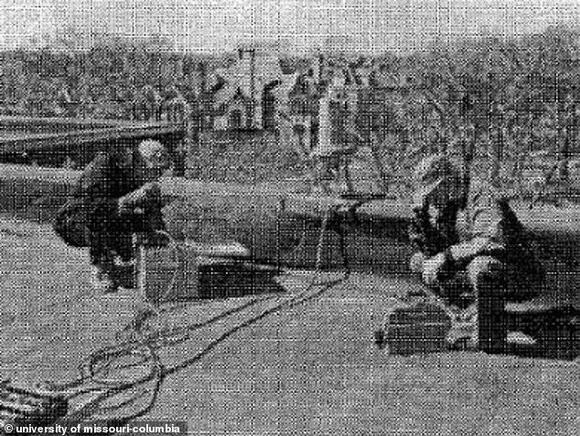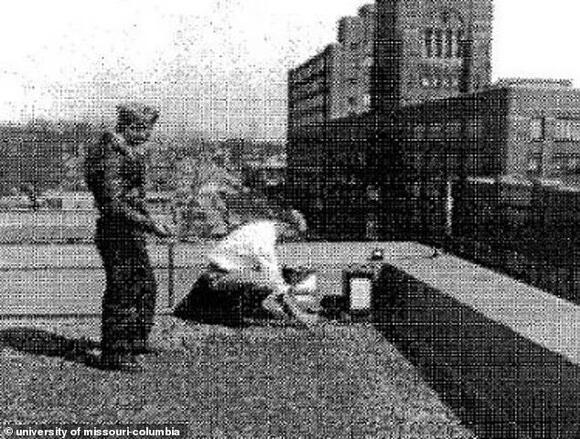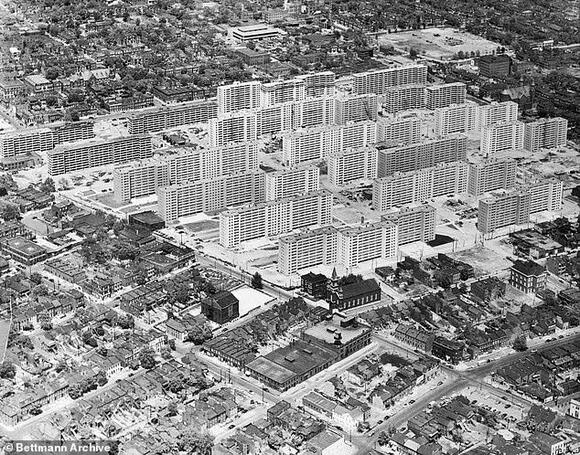The US Army has admitted to spraying a mysterious chemical fog over dozens of US neighborhoods, which residents now claim is giving them cancer decades later.
These secret tests took place in the 1950s and 1960s, in areas such as St Louis, Missouri; Fort Wayne, Indiana; Corpus Christi, Texas, and 29 other cities throughout the US and Canada.
Over the years, residents in these of densely populated areas, including St Louis's Pruitt-Igoe housing complex, saw trucks and rooftop devices spraying a thick, foul-smelling fog that stuck to their skin and made many children feel sick.
What the military didn't tell Americans was that the spray contained zinc cadmium sulfide (ZnCdS), a powder which can cause cancer, kidney damage, or lung problems if inhaled in large amounts over time.
The Army sprayed the cadmium-filled fog to mimic and study how biological weapons may have spread through cities during the Cold War, choosing areas like St Louis because they resembled Soviet cities like Moscow.
While the Army has maintained that the exposure levels were low enough not to cause serious harm, key records from a report examining the fog's health risks are still missing, leaving many to doubt the claims that the spraying was safe.
Now, former residents from the Pruitt-Igoe housing complex have come forward to reveal that many of them have developed rare forms of cancer, while others in their families have already died from diseases that may be linked to the fog.
Pruitt-Igoe resident Cecil Hughes said: 'They didn't ask our permission. We didn't ask for them to spray us. My government used me like I was a Guinea pig.'

Although Pruitt-Igoe was demolished in the 1970s, a group of residents, who were children at the time of the spraying, spoke to NewsNation about the long-term diseases that spread through in their community after the Army testing.
James Caldwell said he was diagnosed with a rare type of lymphoma and added that he believed it's linked to the spraying since the disease doesn't run in his family.
Caldwell noted that the fog was sprayed from a flatbed truck that carried a large machine on the back with a big nozzle.
'You couldn't even see through it; it was that thick, and it would adhere to our skin,' Caldwell said.
'And as far as the guys on top of the buildings, they tried to portray them to us as maintenance workers, but what are the maintenance workers doing in a hazmat suit? They had masks and goggles,' he added.
Jacquelyn Russell revealed she lost two siblings to cancer, while many of her neighbors had kidney, brain, and eye cancers, which she attributed to the ZnCdS fog.
Former resident Ben Phillips added: 'My parents' friends started dying. I went to 10 funerals, and about seven or eight of them were cancer-related deaths.'
Despite the many residents claiming this Cold War test caused their cancers, there is still no definitive proof connecting the ZnCdS spraying to any health problems, even after 70 years.

Decades after the tests took place, the Army publicly acknowledged it conducted dispersion tests involving zinc cadmium sulfide as part of Operation LAC (Large Area Coverage) and other biological warfare experiments.
The tests were designed to study the dispersal patterns of chemical agents, using the St Louis housing projects and many other American neighborhoods as stand-ins for potential Russian targets.
The government's admission came in the mid-1990s after declassified documents were released, quickly leading to public outrage and a congressional investigation into the safety of the chemical fog.
In 1997, the National Research Council, a non-governmental scientific body, released a 387-page report on the ZnCdS spraying, confirming the Army's claims that the low levels of ZnCdS being sprayed were safe and were unlikely to cause serious health problems.
However, the NRC report noted that health risks, such as lung cancer, kidney issues, and weakening bones from cadmium exposure, could not be fully ruled out due to limited data on long-term effects.
The NRC report highlighted that some Army records about the ZnCdS tests were missing or still classified, making it hard to know the full scope of what was sprayed in the 1950s and 60s.
Those missing documents included the Joint Quarterly Report 5, a classified report detailing the ZnCdS spraying tests written by a scientist named Philip Leighton, who was involved in the Army's biological warfare research program.
According to NewsNation, a Freedom of Information Act request for the missing document filed in May has gone unanswered, despite the law giving the government only 20 working days to respond.

The residents of Pruitt-Igoe have demanded compensation and further studies of the mysterious fog but admitted that whatever is done will come too late to help them.
'They're waiting on all of us to die,' Phillips claimed. 'And when we die, maybe they're going to wait for our kids to die.'
Despite residents' demands, public hearings, and advocacy groups calling for action, the federal government has not provided compensation, issued an official apology, or acknowledged health impacts from the ZnCdS spraying.
The Daily Mail could also not find any records that the Environmental Protection Agency (EPA) or the Department of Health and Human Services (HHS) conducted new health studies, which Missouri state lawmakers requested.